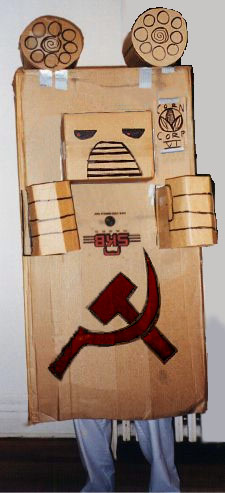 Name: Corn Corps VI
Name: Corn Corps VI
History:
Unlike many of 1824 Techno's robots, who are simply crafted in a workshop or captured while wandering the countryside, those of the six Corn Corps were massed produced in a concerted effort. Early in 1939, Buel, Hugh, and Ambrose saw that the aggressive brinksman tactics of Adolf Hitler and his cadre of Nazis would soon lead Europe and the world into war. Instead of turning a cold cheek to this growing fascist malignancy, 1824 Techno organized a fund drive to create an entire robot army whose sole purpose was to wage battle without human casualties. In isolationist America, the band had little success in raising the money required to build an astonishing 600 war-bots. With little time to spare, they packed their instruments and sailed to Europe to tour, hoping to be received more enthusiastically.
In a whirlwind train tour of Europe, 1824 Techno played in Dublin, London, Paris, Toulouse, Madrid, Lisbon, Rome, Berlin, Warsaw, Budapest, Copenhagen, and Moscow. During the exhausting weeks of the tour, the band managed to raise an incredible amount of money. While in Rome and Berlin, where they set up shows illegally, 1824 Techno was confronted by gangs of fascist youths bearing weapons, so they were forced to hastily leave. Several robots died defending the band and the fans.
With plenty of funds but little time to spare, 1824 Techno set up a factory and workshop in Scotland, on an ancient plot of land inherited by Hugh. When Hitler invaded Poland on September 1, 1939, precious few robots were made. The band worked furiously, but soon Hitler had overrun France and captured Paris. Where were the robots to go to help the Allies' cause?
The Robot Army was completed soon after Hitler invaded the USSR in June of 1941. It was fully 600 robots strong, consisting of six 100-robot corps, christened The Robot Guard, The Steam Men, The Iron Cranks, The Mechanical Men, The Steel Gears, and The Corn Corps. Stalin, desperate for assistance after his mighty armies collapsed, unknowingly accepted the Robot Army, shipped to the USSR known as "armored vehicles." Upon opening the massive crates, the Soviets were astonished. With little idea of what was given to them but too full of suspicion to ask the Allies how to use the robots, they mothballed all 600.
Then, after nearly two years of complete inactivity, the Robot Army was activated for use. During the monumental Kursk Offensive, in which thousands of German and Soviet soldiers were killed and hundreds of tanks destroyed, the Robot Army was employed as a shock force. During the several battles of the Nazi offensive, it performed excellently. More mobile than tanks and armored just as well, the robots tore huge salients in the German front. Unfortunately, little was done to reinforce the robots. With no orders to withdraw from General Sbaitso, a robot himself, they held their ground at great cost. Running out of fuel and ammunition, the Robot Army simply melted away under constant pressure. With but a few dozen robots left, even the cold steel heart of General Sbaitso felt pity and ordered a withdrawal. The Germans, battered and bloodied, regained their ground.
There were no Soviet casualties, but the fields full of smashed robots, lying in puddles of their own oil, attested to the great price that was paid.
The Robot Army was soon after decommissioned. Hugh, Buel, and Ambrose were sent the last of the robots. Upon reaching England, they were treated to a hero's welcome--a spirited parade in London.
Year made: 1939-41
Weight: Between 1 and 2 tons
Height: Between 8 and 10 feet tall
Power Plant: 1 Rolls Royce V, water-cooled, varying in horsepower
Armaments: Several variants were made. The basic "grunt" variant was equipped with a rapid-fire 20mm cannon on its right arm and a Fist of Fury close combat weapon on its left. The "tank buster" variant was equipped with two 75mm high-velocity guns, one on each arm mount. The "artillery" variant was equipped with two shoulder-mounted rocket launchers and two Fists of Fury. A fourth "medic" variant was equipped with only a light machine gun, but carried a robot-specific tool kit and anesthetic. The "general" variant, of which only seven were made, carried a host of 20mm cannon, heavy machine guns, and rocket launchers.
Special Notes: The "general" variant was given the most sophisticated analog programming and communications equipment in the world at the time to perform its command duties. 1824 Techno's research in this area may have led to the development of early personal computers.
Present Day: Many members of the Robot Army still exist. The Corn Corps (VI Corps) made an exhibition on Halloween in 1998. They were hotly engaged in combat with drunken mobs, but several withdrew to fight again in the future. Several more sightings have been made at 1824 Techno's more recent shows. The robots of the other five corps are still active, waiting for a chance to blaze into combat once again...